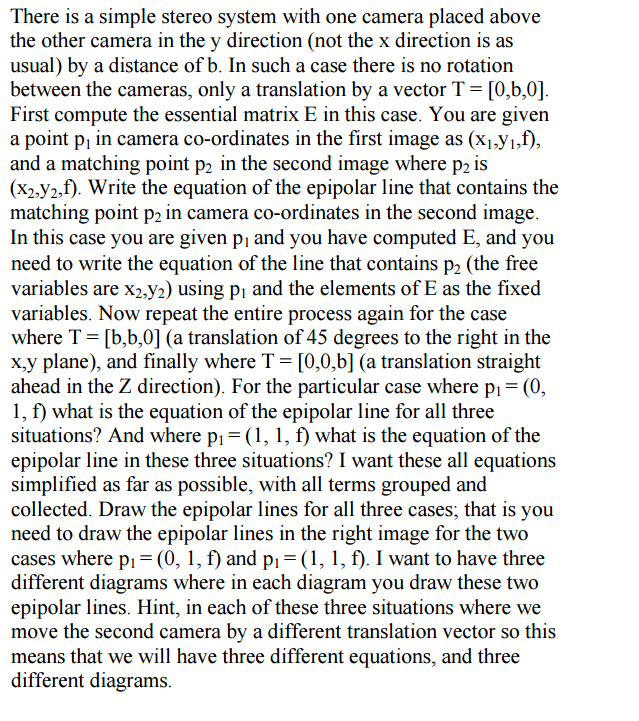
There is a simple stereo system with one camera placed above the other camera in the y direction (not the x direction is as usual) by a distance of b. In such a case there is no rotation First compute the essential matrix E in this case. You are given a point pl in camera co-ordinates in the first image as (x_1, y_1, f), and a matching point p_2 in the second image where p_2 is (x_2, y_2, f). Write the equation of the epipolar line that contains the matching point p_2 in camera co-ordinates in the second image. In this case you are given pl and you have computed E, and you need to write the equation of the line that contains p_2 (the free variables are x_2, y_2) using pl and the elements of E as the fixed variables. Now repeat the entire process again for the case where T = [b, b, 0] (a translation of 45 degrees to the right in the x, y plane), and finally where T = [0, 0, b] (a translation straight ahead in the Z direction). For the particular case where p_1 = (0, 1, f) what is the equation of the epipolar line for all three situations? And where p_1 = (1, 1, f) what is the equation of the epipolar line in these three situations? I want these all equations simplified as far as possible, with all terms grouped and collected. Draw the epipolar lines for all three cases, that is you need to draw the epipolar lines in the right image for the two cases where p_1 = (0, 1, f) and p_1 (1, 1, f). I want to have three different diagrams where in each diagram you draw these two epipolar lines. There is a simple stereo system with one camera placed above the other camera in the y direction (not the x direction is as usual) by a distance of b. In such a case there is no rotation First compute the essential matrix E in this case. You are given a point pl in camera co-ordinates in the first image as (x_1, y_1, f), and a matching point p_2 in the second image where p_2 is (x_2, y_2, f). Write the equation of the epipolar line that contains the matching point p_2 in camera co-ordinates in the second image. In this case you are given pl and you have computed E, and you need to write the equation of the line that contains p_2 (the free variables are x_2, y_2) using pl and the elements of E as the fixed variables. Now repeat the entire process again for the case where T = [b, b, 0] (a translation of 45 degrees to the right in the x, y plane), and finally where T = [0, 0, b] (a translation straight ahead in the Z direction). For the particular case where p_1 = (0, 1, f) what is the equation of the epipolar line for all three situations? And where p_1 = (1, 1, f) what is the equation of the epipolar line in these three situations? I want these all equations simplified as far as possible, with all terms grouped and collected. Draw the epipolar lines for all three cases, that is you need to draw the epipolar lines in the right image for the two cases where p_1 = (0, 1, f) and p_1 (1, 1, f). I want to have three different diagrams where in each diagram you draw these two epipolar lines







